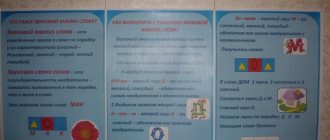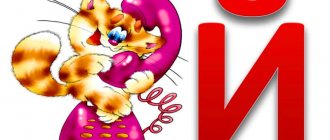Sound analysis of a word: what is it
First of all, it is worth giving a definition. So, sound analysis of a word is the determination of the order in which sounds are placed in a particular word and the characterization of their features.
Why do children need to learn to perform sound analysis of a word? To develop phonemic awareness, that is, the ability to clearly distinguish between sounds and not confuse words, for example: Tim - Dima. After all, if a child is not taught to clearly distinguish words by ear, he will not be able to write them down correctly. And this skill can be useful not only when studying the grammar of your native language, but also when studying the languages of other countries.
The order of parsing words by sounds
When performing a sound analysis of any word, you must first place the stress and then divide it into syllables. Then find out how many letters are in the word and how many sounds. The next step is to analyze each sound step by step. After this, it is calculated how many vowels and how many consonants are in the analyzed word. At first, it is better for children to be given simple one-syllable or two-syllable words for analysis, for example their names: Vanya, Katya, Anya and others.
When the child has gradually figured out how to correctly carry out analysis using simple examples, it is worth complicating the analyzed word examples.
Sound analysis of a word: diagram
When working with very young children, special colored cards are used to better assimilate information.
With their help, children learn to create a sound analysis scheme.
The scarlet card is used to represent vowel sounds. Blue - hard consonants, green - soft. To indicate syllables, two-color cards in the same color scheme are used. With their help, you can teach your child to characterize sounds and whole syllables. You also need a card to indicate stress and a card to show the division of the word into syllables. All these designations, which help teach a child to make a sound analysis of a word (the diagram plays an important role in this), are approved by the official school curriculum in Russia.
Work on the development of sound analysis of words takes place in the following sequence - from easy tasks to more difficult ones:1. Highlighting the stressed, then unstressed vowel at the beginning of the word: duck, window; watermelon, hut
2. Isolation of consonant sounds in reverse syllables and at the end of words: AP, OH; soup, cat, poppy seed
3. Complete sound analysis of the reverse syllable: UM - U, M.
4. Isolation of a consonant in a direct syllable and at the beginning of a word: MU, juice.
5. A vowel in the middle of monosyllabic words like onion.
6. Complete analysis of straight syllables and monosyllabic words! but - N, O; poppy - M, A, K.
7. Emphasizing the vowel sound at the end of a two-syllable word: hand.
8. Dividing words into syllables: LA-PA, KA-UUA.
9. Complete sound-syllable analysis of two-syllable words: ZU-BY, 3, U, B, Y.
10. Monosyllabic words with a combination of consonants at the beginning or end of words: table, brother; umbrella, wolf.
11. Words with a combination of two consonants belonging to different syllables, dividing such words into syllables: cat, bag, spring.
Further, the formation of sound-syllable analysis is carried out by complicating the rhythmic-syllabic structure of the word:
a) three-syllable words with open syllables: ma-shi-na, ra-bo-ta;
b) three-syllable words with one closed syllable at the end of the word: mo-lo-tok;
c) three-syllable words of different syllabic composition: ver-tush-ka, va-len-ki;
d) four-syllable words: che-re-pa-ha.
Children learn to divide three- to four-syllable words into syllables by clapping, recognize the given sound in the words, and a full sound analysis is not necessary.
The first stage in the formation of sound analysis is the isolation of sound without relating it to its place in the word, the second is the ability to indicate the place and sequence of sounds, the full sound composition of the word.
First of all, the concept of “word” itself should be clarified. In response to the question of what words he knows, the child can pronounce like this: bae, meh, he can pronounce a sentence, at best he can name words-nouns, i.e. names of objects. In various speech games, he gradually realizes that words denote not only objects, but also their qualities, properties, actions, and signs of action.
Having mastered the concept of “word” and learned to conduct a complete sound analysis of words like poppy, the child easily begins to “write” words. For this, a graphical diagram is used - a horizontal row of cells under the picture according to the number of sounds in the word, each of them, when “written”, is closed with a corresponding chip. These are cardboard colored squares measuring five by five centimeters: blue ones represent hard consonant sounds, green ones represent soft consonant sounds, and red ones represent vowel sounds. It is recommended to make five chips of each color. You should not start learning sound analysis using a diagram with letters, since at first school they also use chips and diagrams. The child must be prepared for this.
The motto of such classes could be the words: “We don’t know letters, but we write and read by sound signals.” In this case, it is necessary to highlight the sound intonationally: long pronunciation - S, Sh; with aspiration - K, T, after which the cell is closed with the corresponding chip.
An example of “writing” the word soup (the child is given a diagram of three squares): “Sssup - the sound C is hard, indicated by a blue chip (cover the first cell); suuup - the vowel sound U, indicated by a red chip (we close the second cell); we read - ssuu...p, the sound P is missing, it is also indicated by a blue chip (we close the third cell); Let’s read it together: ssuup.” While reading a word, the child moves the finger of his right hand under the diagram. After this, you can offer additional tasks: name the vowel or consonant sounds in a word, hard or soft, voiced or voiceless.
When dividing words into syllables, syllable chips (three by five centimeters) of any color except red, blue and green are used. For faster recognition of syllables, you can offer game techniques: “I will name the syllable, and you will name the sounds (MA - M, A); I will name the sounds, and you will name the syllable (C, A - SA).” After this, a sound-syllable analysis of disyllabic words is carried out.
An example of “writing” the word teeth: “This word has two syllables (the child places two syllable chips at some distance from each other); the first syllable is ZU, we hear the sounds 3, U; We designate them with blue and red chips and read zzuu together.” Then the second syllable is formed in the same way and the entire word is read.
At first, it is recommended to use cards with images of syllables and sounds: one syllable, and at the bottom two or three sound cells - for monosyllabic words; two syllables, and under them two cells - for two-syllable words like teeth. With the help of such a scheme, when “writing” a word, it is easier for a child to detect his mistake - missing a sound, although it does not allow him to find out exactly where the mistake was made.
Over time, the scheme is removed, children work with some chips, and later with letters.
When familiarizing yourself with a sentence, a long strip-chip is added, about ten by twenty centimeters, the beginning of which has a protrusion upwards of two to three centimeters (similar to a lying letter G). The children are explained that each sentence begins to be written with a capital letter, this is indicated by the protrusion of the chip. At the end of it, a dot is placed (you need to prepare two by two centimeter chips with a large dot in the center).
In addition, when analyzing a sentence, you will need word chips, approximately seven by twelve centimeters. Some of them should have protrusions - “capital letters”.
The complete diagram looks like this:
Over time, the scheme is removed, children work with some chips, and later with letters.
When familiarizing yourself with a sentence, a long strip-chip is added, about ten by twenty centimeters, the beginning of which has a protrusion upwards of two to three centimeters (similar to a lying letter G). The children are explained that each sentence begins to be written with a capital letter, this is indicated by the protrusion of the chip. At the end of it, a dot is placed (you need to prepare two by two centimeter chips with a large dot in the center).
In addition, when analyzing a sentence, you will need word chips, approximately seven by twelve centimeters. Some of them should have protrusions - “capital letters”.
The complete diagram looks like this:
Larisa was washing the floor. Offer.
________ _____ ____. Words.
__ ___ __ __ __ __. Syllables.
.. .. .. .. .. … Sounds.
According to the assignment, the child can draw a diagram in a notebook, but first it is necessary to compose a phrase based on the plot picture, determine the number of words and syllables.
At first, prepositions, conjunctions and particles are excluded, but gradually, in various speech games, the child realizes with the help of the teacher that prepositions and conjunctions: and, a, but, yes - these are small words. Without them, the proposal cannot be made. For example: The pen is lying... on the table. Children give hints “on the table.” All that remains is to contrast the location of the object: in the table, above the table, under the table, etc.
Over time, the sentence scheme is removed, the chips are replaced with letters from the box of letters and syllables.
Auditory control leads to the formation of the ability to isolate sound from any position, carry out a complete sound-syllable analysis and synthesis of words of two or three syllables, as well as compose and divide sentences into words. All this helps prepare children for mastering literacy: reading and writing, composing phrases from the letters of a cut cash register.
Vowel sounds and their brief characteristics. Diphthongs
Before you start analyzing a word, it is important to know what features all phonetic sounds (vowels/consonants) have. When teaching children in the early stages, it is necessary to provide information only about the simplest properties; the child will learn everything else in high school.
Vowel sounds (there are six of them: [o], [a], [e], [s], [u], [i]) can be stressed/unstressed. Also in Russian there are letters that in a certain position can produce a pair of sounds - ё [yo], yu [yu], ya [ya], e [ye].
If they follow consonants, they sound like one sound and add softness to the preceding sound. In other positions (the beginning of a word, after vowels and “ъ” and “ь”) they sound like 2 sounds.
Sound-letter analysis of a word
There are a huge number of words in the Russian language that are written differently from how they are pronounced.
For example, we say “khArAsho”, but we know that we should write the word “GOOD”.
To learn to understand what sounds words are made of, schools perform a task called phonetic analysis of a word.
Phonetics
is a branch of the science of language that studies the sounds of speech.
Phonetic analysis is the analysis of a word from the point of view of its correct pronunciation.
Phonetic analysis is also called sound-letter analysis, because during analysis, the number of letters, sounds, stress in a word is determined, vowels and consonants are identified, and their classification is carried out.
Thus, phonetic analysis reflects the “sound” of the word, the correct pronunciation, taking into account the established rules and traditions of Russian speech. Sound-letter analysis is aimed at parsing a word into letters and sounds, finding out that the same letters in different positions can mean different sounds.
Children often have difficulty performing phonetic parsing of words. The reasons may be different. But two main ones can be distinguished:
- the child does not have the necessary knowledge and rules of phonetic analysis;
- or his phonemic hearing is poorly developed, i.e. the ability to isolate, reproduce, and distinguish speech sounds.
First you need to clearly understand the difference between letters and sounds.
Sounds are the smallest sound units of speech. We hear and pronounce sounds. During phonetic analysis, sounds are written in square brackets.
Letters are signs to represent sounds in writing. We see and write letters.
Brief characteristics of consonants
There are thirty-six consonant sounds in our language, but they are represented graphically by only twenty-one characters. Consonants are hard and soft, as well as voiced and voiceless. They also may/may not form pairs.
The table below lists voiced and unvoiced sounds that can form pairs, and those that do not have this ability.
It is worth remembering: the consonant sounds [th`], [ch`], [sh`] are soft in any position, and the consonants [zh], [ts], [sh] are always hard. The sounds [ts], [x], [ch`], [sch`] are absolutely always unvoiced, [m], [n], [l], [р], [й`] are (sonorous) or voiced .
Soft and hard signs do not produce sounds. The soft sign makes the previous consonant soft, and the hard sign plays the role of a sound separator (for example, in Ukrainian the apostrophe plays a similar role).
Phonetic analysis reminder
Remember also the following rules:
- After the consonants Ж, Ш, Ц we hear the sound [s]: giraffe [zhiraf];
- Doubled consonants are indicated by one sound;
- All words in transcription are written with a small letter;
- An unpronounceable consonant is not written;
- Voiced paired consonants are replaced by their voiceless pair in a weak position: girlfriend [padrushka], boot [boots];
- The sounds [o], [e] are only under stress.
Every elementary classroom has a letter and sound tape. It is advisable that she be at home. It's easy to print or draw yourself. How to use it is discussed in more detail here.
The tape of letters and sounds greatly facilitates the development of sound-letter parsing.







